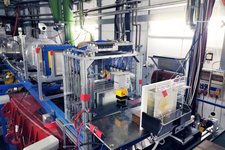Proton and Carbon-ion FLASH
FLASH radiotherapy is considered a new potential breakthrough in cancer treatment. Ultra-highdose rates (> 40 Gy/s) have been shown to reduce toxicity in the normal tissue without compromising tumor control, resulting in a widened therapeutic window. These high dose rates are more easily achievable in the clinic with charged particles, and clinical trials are, indeed, ongoing using electrons or protons. FLASH could be an attractive solution also for heavier ions such as carbon and could even enhance the therapeutic window. GSI biophysics is intensively working on the field of FLASH irradiation. The main goals are to understand the FLASH effect and to show and quantify the FLASH for carbon beam. Furthermore, we are working for a clinical solution for proton FLASH using 3D range modulators.
Proton FLASH developments for VARIAN
GSI and Technische Hochschule Mittelhessen (THM) closed in 2022 a research contract with VARIAN Medical Systems (a subsidiary of Siemens Healthineers) for the development of 3D-Range modulators (3DRM, see also below 3D-Path) that shall be used soon in the clinical application of FLASH beam application with proton beams. GSI (radiation physics group) is mainly responsible for the conduction of the 3D dose measurements with their self developed water phantom, but also involved in the development in the 3DRMs, in particular in optimizing the printing process and quality assurance.
Figure: left: Setup for 3D high-resolution dose measurements with the water phantom ‚WERNER‘ (developed at GSI); middle: measured 3D-dose (set of 60.000 dose points) and the corresponding Monte Carlo simulation; right: examples for 3DRMs, here for spherical target volumes and a single pin (upper left)
Carbon-Ion FLASH (GSI)
The GSI synchrotron enables a particularly high beam intensity (≥ 5×109 ions/spill), which is significantly higher than most other existing facilities worldwide. This enable FLASH irradiation also for medium sized targets (e.g. 50 -100 ccm), which gives GSI an unique feature. Starting in 2019 with many tests at the Heidelberg ion-therapy facility (at 10 times lower beam intensity) and continuing at GSI (from 2021), we could the improve and tune the beam monitoring and dosimetry for FLASH Intensity. Finally, this enabled a series of cell and preclinical experiments proofing that FLASH also works for carbon beams. Four first Carbon-ion papers for FLASH-radiobiology and dosimetry have been be published [3,4,5,6].
The future research program includes further preclinical experiments, irradiation of clinically relevant tumors (>50 ccm) using 3D-range modulators and further improving of the dosimetry.

![Figure: Measured saturation curves and simulations in beam monitors (parallel-plate ionisations chambers), showing that He-CO2 mix as filling gas enables linear beam monitoring also at FLASH intensities [figure from reference [figure from reference [6]]](/fileadmin/_processed_/7/a/csm_Measured_saturation_1e7c596935.png)
![Figure: Cell experiments for Carbon-ion FLASH showing higher cell survival at FLASH intensity (at low oxygenation level) [figure from reference [4]]](/fileadmin/_processed_/b/4/csm_Celll_experiments_of_carbon-_ion_a953b52b6b.png)
3D-Path: 3D-Range modulators (ZIM)
Technische Hochschule Mittelhessen (THM) and GSI started in 2017 together with the Ernst-Abbe-Hochschule Jena (FB SciTec, Prof. Bliedtner) and three industrial partners (Fa. Messtronik, St. Georgen ; Fa. Medcom, Darmstadt und Fa. Portec, Zella-Mehlis) a BMBF funded project calles “3D-Path” for creating so-called 3D range modulators.
(Gefördert durch das ZentraleInnovationsprogrammMittelstand (ZIM-AiF), Fördernummer ZF4365702BAB)
Goal of this project was to develop high-precision 3D printed modulators that enable extremely fast irradiation for raster-scanning beam application within one energy layer only. This project was very successful and could prove prove a high quality dose delivery for medium sized target volumes (~5 cm). MC simulation could exactly verify the measured dose distributions [7,8,9].
Luckily, this development was the ideal starting point for the realisation of FLASH irradiation with particles (see above), which the came up a bit later.
Selected Publications:
[1] MC. Vozenin et al, The Advantage of FLASH Radiotherapy Confirmed in Mini-pig and Cat-cancer Patients, Clin. Cancer Res. (2019) 25 (1): 35–42. https://doi.org/10.1158/1078-0432.CCR-17-3375
[2] B. Sørensen et.al, In vivo validation and tissue sparing factor for acute damage of pencil beam scanning proton FLASH, Radiotherapy and Oncology 167 (2022) 109–115, https://doi.org/10.1016/j.radonc.2021.12.022
[3] Weber et al, FLASH radiotherapy with carbon ion beams, Med. Phys. 2021 doi:10.1002/mp.15135
[4] Tinganelli et al, Ultra-High Dose Rate (FLASH) Carbon Ion Irradiation: Dosimetry and First Cell Experiments, Int. J. Radiat. Onc. Biol. Phys. 2021. doi:10.1016/j.ijrobp.2021.11.020
[5] Tinganelli et al, FLASH with carbon ions: Tumor control, normal tissue sparing, and distal metastasis in a mouse osteosarcoma model, Radiother. Oncol. 2022, doi: 10.1016/j.radonc.2022.05.003
[6] Baack et al, Reduction of recombination effects in large plane parallel beam monitors for FLASH radiotherapy with scanned ion beams, Phys. Med. Biol. 2022, doi:10.1016/j.ejmp.2022.10.029
[7] Simeonov et al, 3D range-modulator for scanned particle therapy: development, Monte Carlo simulations and experimental evaluation, Phys. Med. Biol. 62 (2017) 7075–7096, https://doi.org/10.1088/1361-6560/aa81f4
[8] Simeonov et al, Development, Monte Carlo simulations and experimental evaluation of a 3D range-modulator for a complex target in scanned proton Therapy, Biomed. Phys. Eng. Express 8 (2022) 035006 , https://doi.org/10.1088/2057-1976/ac5937
[9] Schuy et al, Technical note: Vendor‐agnostic water phantom for 3D dosimetry of complex fields in particle therapy, J. Appl. Clin. Med. Phys. (2020), https://doi.org/10.1002/acm2.12996




![Figure: FLASH vs Conventional irradiation with electron beams [figure from reference [1]]](/fileadmin/_processed_/c/9/csm_FLASH_Conventional_50261a4029.jpg)
![Figure: Comprehensive mice experiment with high statistics. A very clear and significant reduction of normal tissue reaction is shown here for proton FLASH. The experiment was conducted at the Aarhus proton therapy facility [figure from reference [2]]](/fileadmin/Biophysik/Forschungsfelder/Radiation_Physics_Group/Proton_and_Carbon-ion_FLASH/Compreensive_mice.png)

